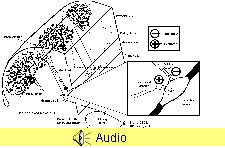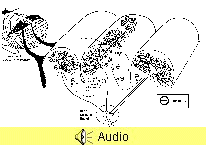Circuitry
Folia
 In addition to the
climbing fiber and mossy fiber-granule cell-parallel fiber
input to the Purkinje cells, which are EXCITATORY,
there are other inputs to the Purkinje cell that are
INHIBITORY. The first cell that we will
talk about lies in the granule cell layer and is called a
Golgi cell (sorry there is no Golgi cell layer!!). Compared
to the many millions of small granule cells (hence the name
granule cell layer), there are relatively few Golgi cells
and they are much larger than granule cells. The dendrites
of the Golgi cells lie in the molecular layer (in no
particular plane) and are EXCITED by the parallel
fibers of granule cells. The axon of the Golgi cell enters
into a complex arrangement with the mossy fiber
terminal-granule cell dendrite (shown above) such that
the Golgi cell axon INHIBITS (via GABA) the mossy
fiber-granule cell relay. This is called feedback
inhibition, because the Golgi cell inhibits information that
is coming into the cerebellar circuitry.
In addition to the
climbing fiber and mossy fiber-granule cell-parallel fiber
input to the Purkinje cells, which are EXCITATORY,
there are other inputs to the Purkinje cell that are
INHIBITORY. The first cell that we will
talk about lies in the granule cell layer and is called a
Golgi cell (sorry there is no Golgi cell layer!!). Compared
to the many millions of small granule cells (hence the name
granule cell layer), there are relatively few Golgi cells
and they are much larger than granule cells. The dendrites
of the Golgi cells lie in the molecular layer (in no
particular plane) and are EXCITED by the parallel
fibers of granule cells. The axon of the Golgi cell enters
into a complex arrangement with the mossy fiber
terminal-granule cell dendrite (shown above) such that
the Golgi cell axon INHIBITS (via GABA) the mossy
fiber-granule cell relay. This is called feedback
inhibition, because the Golgi cell inhibits information that
is coming into the cerebellar circuitry.
 The parallel fibers of
granule cells (which travel in the molecular layer) also
excite the dendrites of basket cells. Both the
dendrites and somas of the basket cells lie in the molecular
layer. These dendrites, like those of Purkinje cells, lie
in a plane that is transverse to the long axes of the
folia. The axons of basket cells also run in this plane
(transverse to the long axis of the folia) and terminate on
the somas of the Purkinje cells. The inhibition of Purkinje
cells by the basket cell axons is called feedforward
inhibition. Remember, inhibition of the
input=feedback (Golgi cell axon-mossy
fiber-granule cell relay) while inhibition of the
output=feedforward (basket cell axon-Purkinje
cell initial segment). Another way to look at these types of
inhibition is whether the inhibiting cell is acting on an
"earlier" or "later" cell in the cerebellar circuitry.
The parallel fibers of
granule cells (which travel in the molecular layer) also
excite the dendrites of basket cells. Both the
dendrites and somas of the basket cells lie in the molecular
layer. These dendrites, like those of Purkinje cells, lie
in a plane that is transverse to the long axes of the
folia. The axons of basket cells also run in this plane
(transverse to the long axis of the folia) and terminate on
the somas of the Purkinje cells. The inhibition of Purkinje
cells by the basket cell axons is called feedforward
inhibition. Remember, inhibition of the
input=feedback (Golgi cell axon-mossy
fiber-granule cell relay) while inhibition of the
output=feedforward (basket cell axon-Purkinje
cell initial segment). Another way to look at these types of
inhibition is whether the inhibiting cell is acting on an
"earlier" or "later" cell in the cerebellar circuitry.